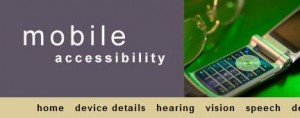 MMF (Mobile Manufacturer Forum) reported that mobile phone makers have agreed to enhance their reporting of features on mobile phone models that can assist customers with special needs or disabilities.
MMF (Mobile Manufacturer Forum) reported that mobile phone makers have agreed to enhance their reporting of features on mobile phone models that can assist customers with special needs or disabilities.
"These changes are a direct result of our discussions with users and groups around the world and will make it even easier for consumers to find a phone that will meet their individual needs," said Michael Milligan, Secretary General of the MMF.
Some of the new features to be reported on include whether a particular phone has:
- Adjustable maximum volume control for those with limited or poor hearing.
- A front facing camera which can be used by deaf people to sign or for those with limited dexterity to use two-way video conferencing rather than having to hold and use the phone in a conventional way.
- High contrast display mode which can help people read the screen where there is a lot of ambient light or where they have impaired vision.
- Voice notes; which can help those who have short term memory loss to remember things that may otherwise be forgotten.
Following a recent review with stakeholders around the world, manufacturers have agreed a number of changes to their voluntary reporting scheme and will add details of 15 more features that are becoming more prevalent on mobile phones and which can help make a difference to those with limited vision, hearing, dexterity or cognition.
These changes mean that manufacturers will now report on more than 110 mobile phone features as part of the Global Accessibility Reporting Initiative (GARI). The Global Accessibility Reporting Initiative (GARI) is a project designed to help consumers learn more about the various accessibility features of mobile phones and to help them identify phones with the features that may assist them with their particular needs.
The GARI website is available at: www.mobileaccessibility.info